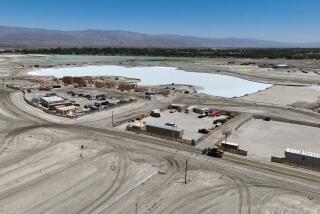A green setting in many respects
- Share via
John and Jacqueline Kennedy honeymooned there. Oprah Winfrey, Jeff Bridges, John Cleese, Rob Lowe and Ivan Reitman live there. Ellen DeGeneres used to, before she sold her estate earlier this year for about $20 million to Eric Schmidt, Google’s chief executive.
Montecito, a verdant enclave in Santa Barbara County once populated by grizzly bears and wolves, has for decades been home to celebrities and corporate titans residing in luxurious estates.
In recent years, Beanie Babies mogul Ty Warner has bought up and renovated classic Montecito resorts, including the Four Seasons Biltmore, the San Ysidro Ranch (where the Kennedys honeymooned in the hills in 1953) and the Montecito Country Club.
Warner, Winfrey and their rarefied ilk have added to the unincorporated community’s aura of fame and fortune. So far, their well-known properties appear to be unscathed by the Tea fire that broke out Thursday night and spread Friday to Santa Barbara proper.
Actor Christopher Lloyd, best known for his roles on “Taxi” and in the “Back to the Future” films, was not so lucky; his house sustained heavy damage in the Tea fire.
The neighborhoods of Montecito are among the wealthiest in the state --although Winfrey and other big-name moguls make up the elite, not the norm. Still semirural, Montecito (whose name is variously translated as “little mountain” or “little woods”) has about 10,000 residents, 93% of whom are white, according to census data. The median income is $140,000, on a par with cities such as La Canada Flintridge and Rolling Hills Estates.
In prehistoric times, hot mineral springs drew Native Americans, who created an early spa in a canyon.
The area was later settled by Mexicans, including many of Santa Barbara’s original families: Romero, Olivas, Robles, Lopez, Lorenzana. By the 1850s and ‘60s, farmers had arrived, tapping creeks and springs to irrigate the dry hills and raise a variety of crops.
“They turned Montecito into the most beautiful green paradise of orchards and farms that you ever saw,” said Maria Herold, curator of the Montecito Assn.’s history committee.
In the late 1800s, the incomparable scenery and balmy climate began to attract wealthy visitors from the Midwest and the East Coast.
In 1887, the first blast of a locomotive whistle echoed through Montecito as the Southern Pacific extended its Coast Line as far as Goleta, according to Walker A. Tompkins, who has written about the area. That same year, San Francisco banker William H. Crocker bought a citrus ranch with his mother-in-law, Caroline Sperry. The upper end of the Crocker-Sperry Ranch was called China Flat, named for Chinese stone masons who camped there in the 1880s.
After the Potter Hotel opened in 1902, patrons included Rockefellers, Carnegies, Fleischmanns (of yeast fame), DuPonts, Swifts and McCormicks. Some established lavish gated estates, as large as 200 acres, with gardens, fountains, pools and tennis courts.
The tradition of eye-popping real estate deals has continued. Winfrey closed a $50-million deal for her 42-acre estate in 2001, one of the costliest private-home purchases in the United States. (Eloise and John Bacon -- a scion of the Libby-Owens Ford glass company fortune -- owned the property. They bought the land in 1934; it was sold only after Eloise Bacon’s death at 100.)
Over the years, fire periodically swept through the groves of native oaks and destroyed property.
Montecito’s thousands of oak, eucalyptus and palm trees -- which complement the Spanish colonial and Georgian architecture -- are a blessing and a curse. The trees have grown thicker over the last half a century, said Herold, a self-described Montecito “old-timer.”
“You could see the ocean from any part of Montecito,” she said. “Now everything has grown up.”
The trees, she added, “are the first to burn.” Herold said the community has changed over the last 40 or so years. Back then, “Everybody knew everybody,” she said. “It was very warm, just the place for a family.”
Still, David F. Myrick, author of a two-volume history called “Montecito and Santa Barbara,” said the place has worked to retain its charm and gentility. The first county zoning in California started in Montecito in the late 1920s, Myrick said. The standard in recent decades has been one house per acre lot, although many of the grand estates remain.
“Most here are not trying to put on a big show,” said Myrick, who has almost finished a third volume of history. “People who live here treasure it and try to keep it from becoming too commercial and overcrowded.”
--
--
(BEGIN TEXT OF INFOBOX)
About Montecito
Population: 9,935
Median household income: $140,036
Occupations: 84% white-collar, 6% blue-collar, 10% service/farm
Owner-occupied housing: 78%
Meaning of name: “little mountain” or “little woods”
Median single-family home price: $2.4 million
Sources: Claritas, DataQuick, Times research
More to Read
Inside the business of entertainment
The Wide Shot brings you news, analysis and insights on everything from streaming wars to production — and what it all means for the future.
You may occasionally receive promotional content from the Los Angeles Times.











